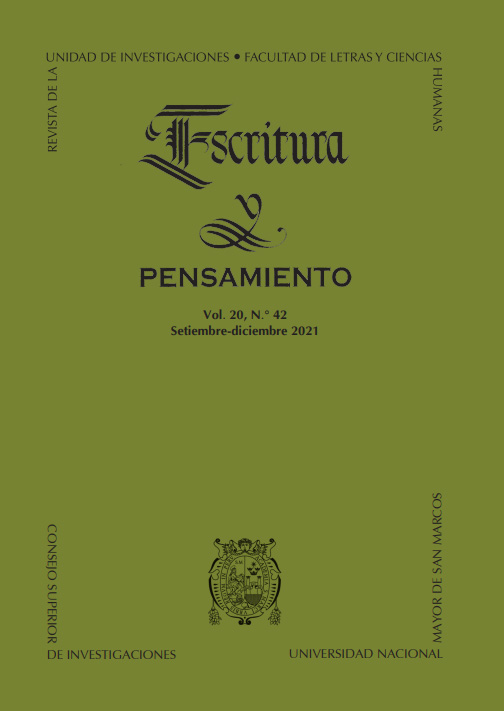The tinkuy in the poem "Katakay" by José María Arguedas
DOI:
https://doi.org/10.15381/escrypensam.v20i42.21894Keywords:
Katatay, poetry, Quechua, tinkuy, semioticsAbstract
Since the end of the 19th century, and even more so in the 20th century, the identity of the Andean man was part of the thematic and aesthetic agenda of the artistic discourses produced in Peru. Along these lines, the poem "Katatay" by José María Arguedas constitutes a speech enunciated from the Andean worldview. As such, it has been hypothesized that in the poem "Katatay" the tinkuy or tension encounter is presented in the form of dialogue. In turn, the sacred is proposed as a tensioning element between the poem's interlocutors, since one fears it and the other understands and explains it. This element, towards the end of the text, is accepted by both interlocutors. As a method of analysis, we have used the categories of Jacques Fontanille's strategic dimension.
References
Arguedas, J. (1972). Katatay. Instituto Nacional de Cultura. http://repositorio.cultura.gob.pe/bitstream/handle/CULTURA/945/Temblar% 20Katatay.pdf?sequence=1
Ajens, A. (2012b). KATATAY II* En torno a los poemas en quechua de J. M. Arguedas. http://letras.mysite.com/aaj290512.html
Cornejo, A. (2000). La Vanguardia: poesía pura y poesía nativista. En Centro de Estudios Literarios Antonio Cornejo Polar y Latinoamericana Editores (Eds.) Literatura peruana. siglo XVI a Siglo XX, 199-205. Centro de Estudios Literarios Antonio Cornejo Polar y Latinoamericana Editores.
Escobar, A. (1972). Presentación. En Instituto Peruano de Cultura (Ed.) Katatay. pp. 8-11 http://repositorio.cultura.gob.pe/bitstream/handle/CULTURA/945/Temblar% 20Katatay.pdf?sequence=1&isAllowed=y
Escobar, A. (1989). Arguedas, el poeta, y su flecha en la palabra. En L. Valera (Ed.). El imaginario nacional. Moro-Westphalen-Arguedas. Una formación literaria, 94-117. Instituto de estudios peruanos.
Espino, G. (2011). Etnopoética: la poesía bicultural de José María Arguedas. En Katatay, 7(9), 36-40. https://edicioneskatatay.com.ar/system/items/fulltexts/000/000/017/original Katatay_N_9_2011.pdf?1462282326
Huamán, C., Julca, Y. y Mamani, M (2019). José María Arguedas: poeta quechua de la transformación. Letras, 90 (132), pp. 110-137. http://dx.doi.org/10.30920/letras.90.132.5
Larrú, M. (2017). De la oralidad hacia la escritura: confluencia y conflicto en la literatura peruana andina. (Tesis de Maestría, Universidad Nacional Mayor de San Marcos). https://cybertesis.unmsm.edu.pe/bitstream/handle/20.500.12672/6485/Larru _sm.pdf?sequence=1&isAllowed=y
Mellado, S. (2011). Dioses, hombres y aeroplanos en Katatay de José María Arguedas. Katatay, 7(9), 41-47. https://edicioneskatatay.com.ar/system/items/fulltexts/000/000/017/original /Katatay_N_9_2011.pdf?1462282326
Ansión, J. (1987). Desde el rincón de los muertos: el pensamiento mítico en Ayacucho. Gredes.
Eliade, M. (1981). Lo sagrado y lo profano. Ediciones Punto Omega. https://antroporecursos.files.wordpress.com/2009/03/eliade-m-1957-lo-sagrado-y-lo-profano.pdf
Estermann, J. (2006). Filosofía andina. Sabiduría andina para un mundo nuevo. Instituto Superior Ecuménico Andino de Teología. https://www.academia.edu/36493848/Estermann_Josef_Filosofia_andina
Fontanille, J. (2014). Prácticas semióticas. Lima: Universidad de Lima.
Kowii, I. (2017). El Tinkuy kichwa: violencia ritual y mecanismo cultural. (Tesis de Maestría, Universidad Andina Simón Bolívar). https://repositorio.uasb.edu.ec/handle/10644/5883
Morocho, S. (2017). Sumak kawsay: ¿estrategia política o filosofía de vida? Universitas, 25 (26), 179-198. https://doi.org/10.17163/uni.n26.2017.07
Ortiz, A. (1973). De Adaneva a Inkarri: una visión indígena del Perú. Ediciones Retablo de Papel
Valiente, T. (2016). Tinkuy. Encuentro de contrarios o diferentes. Una mirada en las fuentes. Indiana, 33(1), 199-220. http://dx.doi.org/10.18441/ind.v33i1.199-220
Downloads
Published
Issue
Section
License
Copyright (c) 2021 Jean Pierre Odar Jimenez

This work is licensed under a Creative Commons Attribution 4.0 International License.
AUTHORS RETAIN THEIR RIGHTS:
a. The authors retain their trademark and patent rights, and also over any process or procedure described in the article.
b. The authors retain the right to share, copy, distribute, execute and publicly communicate the article published in the Escritura y Pensamiento (for example, place it in an institutional repository or publish as part a book), with acknowledgment of its initial publication by Escritura y Pensamiento.
c. Authors retain the right to make a subsequent publication of their work, to use the article or any part of it (for example: a compilation of their work, lecture notes, thesis, or for a book), provided that they indicate the source of publication (authors of the work, journal, volume, number and date).





